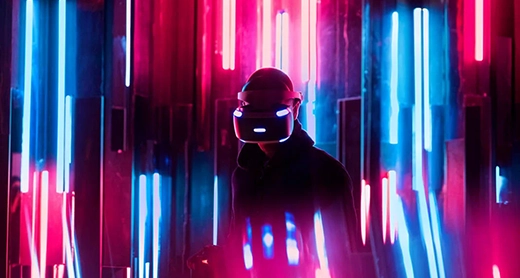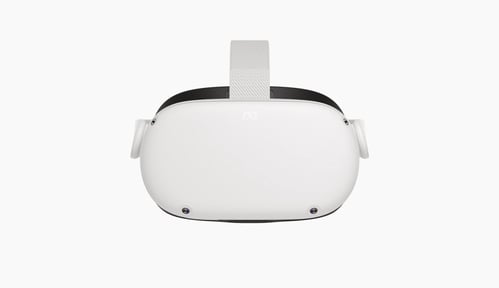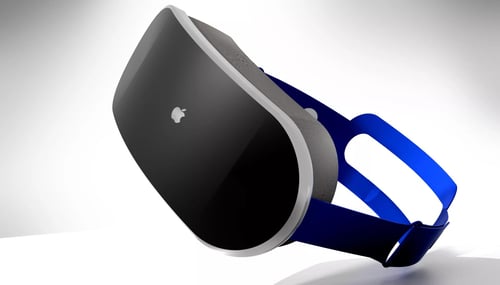by Peter Diamandis: How we shop, interact, and work is about to transform.
 High resolution, low-weight VR headsets in combination with high-bandwidth connectivity and AI-generated environments will allow anyone to shop for everything from clothing to real estate from the convenience of their living room in a fun and highly efficient manner.
High resolution, low-weight VR headsets in combination with high-bandwidth connectivity and AI-generated environments will allow anyone to shop for everything from clothing to real estate from the convenience of their living room in a fun and highly efficient manner.
Need a new outfit? Your AI knows your detailed body measurements and can whip up a fashion show featuring 20 of your photo-realistic avatars wearing the latest 20 designs on a private runway.
Want to see how your furniture might look inside a house you’re viewing online? No problem, your AI can show you, and give you a tour.
Even more exciting is the impact these technologies will have on the future of work. While Zoom, Microsoft Teams, Google Meet, and Slack helped us to work through the pandemic, they lack the social elements we humans need—the innate desire for fully immersive connection. In success, this is coming mid-decade following the release of the next-generation AR/VR headsets.
Early versions of this virtual group workplace will enable anyone to choose a photorealistic avatar and custom surrounding, as you interact with friends, coworkers, and AI bots.
This Metatrend is enabled through the convergence of VR, AI, the metaverse, and high-bandwidth networks.
Let’s dive in…
HOW FAR OFF IS READY PLAYER ONE?
One of the technical hurdles that VR tech will need to overcome is achieving higher resolution.
Resolution is defined as the number of pixels that can be displayed.
For example, ultra-high-definition (HD) TV displays can reach 200 pixels per degree (PPD) at a distance of about 10 feet.
This exceeds the roughly 60 PPD of the human eye, but there’s a caveat. Since VR displays are only 1 or 2 inches from the user’s eyes, they can only reach about 15 PPD. Because the screens in VR headsets sit so close to our eyes, they need to squeeze a massive number of pixels into a small space to reach the definition of, say, a 4K TV.
So, how will we reach human eye-level resolution in VR headsets? How much does VR tech need to get for us to have photo-like realistic resolution like in Ready Player One?
Recent research published in the journal Science presents a potential path.
As the authors of the study note, for VR displays to match the resolution of the human eye, they will need to fit between 7,000 and 10,000 pixels into each inch of display. For reference, current smartphone screens reach just under 500 pixels per inch.
But as the researchers point out, at least 3 new approaches can help close that gap and deliver on the promise of fully immersive, realistic VR experiences:
1. New filtering methods: Most current VR headsets use separate red, green, and blue organic light-emitting diodes (OLEDs). But due to their manufacturing process, these are hard to make smaller. One possible approach that adds colored filters to white OLEDs could help VR headsets reach 60 PPD (human eye-level resolution).
2. “Meta-OLED”: An experimental new OLED design has the potential to achieve up to 10,000 PPD, “approaching the physical limits set by the wavelength of light.”
3. “Foveated display”: Finally, the most likely near-term innovation in VR displays is one that takes advantage of human biology. The human eye is able to reach 60 PPD only in the central part of the retina called the fovea. That sensitivity drops off toward the periphery. But if eye movements can be accurately tracked while wearing a VR headset, then you just need to render the highest definition in the specific section of the display that the user is looking at.
CURRENT STATUS OF VR HEADSETS
Meta has dominated the market with its Quest 2 headset, which has a roughly 85% market share as of 2022.
The next biggest competitor is ByteDance’s Pico, which had roughly 7% share of the market as of last year.
But many VR analysts predict that additional players, particularly Apple, will disrupt the market this year.
Let’s take a brief look at the Meta Quest 2 and what’s rumored about Apple’s headset.

Meta Quest 2 (Source: Meta)
Meta Quest 2: Performance
At 7.5” x 4” x 5.2” and weighing just over 1 pound, and with a price tag of about $400, the Quest 2 has dominated the market.
The Quest 2 has an 1832 x 1920 resolution display for each eye, which is about 50% more pixels than the original Quest. This improved resolution, along with a range of other features, have helped increase adoption of the headset.
About one-third of the more than 400 apps in the Quest Store have generated revenue of $1 million or more, and as of October 2022, users have spent a cumulative total of $1.5 billion in the Quest Store.
Toward the end of 2022, Meta released an upgraded, work-centric version of the headset called the Quest Pro. The Quest Pro is 50% faster than the Quest 2, has a higher resolution screen with 37% more pixels, and has “a larger sweet spot of maximum clarity due to the new pancake lenses.”

Rendering of Apple’s rumored mixed reality headset (Source: Tom’s Guide)
Apple “Reality Pro” Headset: What do we know?
While an Apple AR/VR headset has been rumored for years, several analysts, including Apple analyst Ming-Chi Kuo, suggest that it is scheduled to be released sometime in 2023. Currently dubbed “Reality Pro,” here’s what is rumored thus far about the device:
- Operating System: According to Bloomberg, the headset will run on a new operating system called “xrOS.” Apple has already shared the device with a select group of software developers for testing and to begin creating third-party apps.
- External Cameras: The VR/mixed reality headset is rumored to include a number of external cameras and sensors that will enable body tracking, incorporate real-world environments in a virtual space, and may also allow for “a see-through experience that can deliver a form of augmented reality.”
- Displays: Rumors about the headset’s potential display have ranged from the headset having 12 cameras that feed information to two 8K displays in front of the user’s eyes, to the possibility of two 4K displays and a third, lower-resolution AMOLED display.
- Augmented Reality: Perhaps the main feature of the rumored Apple headset is its mixed reality capability. External cameras are apparently being used to test features like hand-tracking and gesture control, which could include the possibility of being able to type in the air with a virtual keyboard.
- Wearables: Additionally, recent patent filings by the company suggest that it wants to incorporate wearables into its VR/mixed reality headset. These wearables could include an Apple Watch or a VR glove and would allow users to conduct a range of tasks, including hanging up a call or scrolling through pages. Another patent for “smart rings” suggests that these could be used to track finger and hand movements and “boost the capabilities of the external cameras.”
THE 5 MAJOR VR APPLICATIONS
VR will likely impact all aspects of our lives, but let’s look at the 5 primary areas of greatest value.
(1) Gaming: Immersion & Storytelling
VR gaming, with its focus on immersion, marks an evolution in storytelling and exploration.
Immersion has everything to do with attention, and what drives attention is sensory input. The more senses engaged in an activity, the more attention we pay to that activity.
By stimulating as many senses as possible, VR allows users to feel like they are actually present in virtual worlds. This immersion, combined with a 360° view of the surroundings, gives users a life-like experience that can’t be matched by games on flat displays.
Because of this, VR games are expected to make up an increasing share of the overall video game industry.
Gaming research firm Newzoo estimates that VR game revenues will more than double from $1.4 billion in 2021 to $3.2 billion in 2024.
(2) Retail: The magic of AI + VR
Imagine the following scenario: It’s a sunny day in Los Angeles. You’ve got a fundraising luncheon tomorrow, but nothing to wear. The last thing you want to do is spend the day at the mall. No sweat. Your body image data is still current, as you were scanned only a week ago.
Put on your VR headset and have a conversation with your AI assistant.
“I need to buy a dress for tomorrow’s event” is all you have to say.
In a moment, you’re teleported to a virtual clothing store. Zero travel time. No freeway traffic, parking hassles, or angry hordes wielding baby strollers.
Instead, you’ve entered your own personal clothing store. Everything is in your exact size… and I mean everything. The store has access to nearly every designer and style on the planet.
In some respects, that future is already here. Virtual fitting rooms allow customers to try on everything from eyeglasses and shoes to clothes and haircuts.
For instance, Hugo Boss recently partnered with Reactive Reality to allow customers to create personalized avatars to try on clothes. Using Reactive’s PICTOFiT technology, users can create versions of themselves based on their exact measurements and try on thousands of pieces of clothing without leaving their living room.
(3) Engaging Your Clients & Customers
One of the most compelling uses of VR is to enhance meetings and engagement with clients and customers. Two examples of this are wealth advisory and medicine.
Wealth Advisory: If you’re a wealth advisor reviewing your client’s financials and assets, being able to do so in a virtual room with their charts and assets on the walls would give you a permanent “instantiation” of their financial world. Every time you get together, you enter a familiar space to have your quarterly review. On one wall are images of all of your real estate investments. On the other wall are charts and details about your equity portfolio. Everything is dynamic. Double click for more details. Swipe to go back in time. Best of all, the client can always visit to see all the data.
Medicine: Imagine that you’re a physician going over your patient’s “review of results,” examining data from blood tests or imaging studies. Putting all the details up on the walls of your VR office can make it easier to navigate and discuss the results. It’s easy to look back at results over time, and even dive into 3D models of the patient’s heart to explain any recent coronary results.
(4) Education & Training
VR + AI has the potential to revolutionize education through immersion and gamification, allowing educators to create an infinite variety of immersive high-quality teaching environments. We also know that gaming outperforms textbook-based learning in every area. Pilots and surgeons trained on video games and simulations outperform those who are not.
Rather than read about Plato, or his work The Republic, imagine entering a fully immersive, photorealistic metaverse where all of the characters are AI-driven avatars whose words and actions are driven by historically accurate information.
You meet Plato and talk with him while he shows you around ancient Greece and discusses what he learned from Socrates. An otherwise dry and complex subject comes alive.
The research supports this approach. A 2020 report by PwC found that VR can train students 4x faster than traditional classroom methods. The same report also found that VR learners were 3.75x more emotionally connected to the content than their classroom-based peers.
One of the companies reimagining education is Dreamscape Learn (partners with Arizona State University), which merges the power of Hollywood storytelling and immersive VR technology to disrupt how we teach and learn. For example, a 2021 pilot study found that students who used the companies VR platform to complete coursework or an introductory biology class improved their subject matter mastery by an average of 2 letter grades.
But the benefits of using VR to learn aren’t confined to the classroom. Jeremy Bailenson, a Stanford professor and VR pioneer, is also the co-founder of Strivr, which uses VR-based immersive learning to train employees at some of the largest companies in the world.
For instance, during the first year of implementing Stivr’s Immersive Learning program at Walmart, associates using it demonstrated 30% higher employee satisfaction, scored higher on tests 70% of the time, and logged a 10-15% higher rate of knowledge retention than traditional training. Since then, the company has gone on to train 1 million Walmart associates.
Strivr is now using its VR platform to train employees at a range of other companies, including Bank of America, Fidelity, and Verizon.
(5) Work & Collaboration
One of VR’s killer apps will be knocking down the tyranny of Zoom boxes and allowing you to collaborate with colleagues in a photorealistic, virtual office.
Perhaps the best (and most successful) step in this direction is a company called Virbela, led by a brilliant friend and entrepreneur Glenn Sanford.
Virbela, founded in 2012, is using immersive technologies to make it easier for companies to establish digital headquarters with customized experiences, including learning and development programs, recruiting, team meetings and offsites, and industry events.
For example, Deloitte uses Virbela’s platform for its Virtual Campus, where it hosts both internal activities and international events.
eXp Realty, an early adopter of Virbela, has grown to over 86,000 agents and employees, and has expanded to more than 23 international markets. Since going fully remote and moving to the Virbela platform in 2016, the real estate brokerage company is 10x more efficient than its peers in terms of operating costs.
FINAL THOUGHTS
McKinsey predicts that within the next 3 to 10 years, we’ll experience comfortable and high-fidelity VR experiences at scale. By 2030, expect the following 4 developments:
1. Display technology enables true photorealism: Displays with 8K and eventually 16K resolution will become standard as VR headsets are mainstream. This creates virtual environments that are almost impossible for the human eye to distinguish from the physical world.
2. VR headsets include a brain-computer interface (BCI): The advanced neural interfaces allow for bidirectional flow of information from the user to the headset. Inside virtual games and experiences, users will be able to manipulate objects and communicate with others using only their thoughts.
3. Virtual worlds are huge and nearly indistinguishable from real life: The rollout of 6G and the explosion of sensors mean that virtual worlds are larger, faster, and more realistic. Haptics have also improved to the point where realistic senses of smell, taste, and touch are possible in virtual environments.
4. Fully AI-Generated “intelligent NPCs”: Companies like Stability.AI, OpenAI, and Deepmind will use their capabilities to power “artificially intelligent” non-player characters (NPCs) that will drive massive value for the human users.
Ultimately, we no longer live in only one place—we have real-world personae and online personae. This delocalized existence is only going to expand. With the rise of VR, we’re introducing even more layers to this equation.
You’ll have avatars for work and avatars for play.
Kids today playing on Roblox (including my two 11-year olds) are training themselves for the future of how they will work, play, and interact.
Soon, we’re all going to become creators of, and participants in, a near-infinite number of virtual worlds, each populated with assets and storylines interoperable with other virtual environments. The future is truly faster than you think.















































